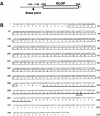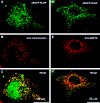The Xq22 inversion breakpoint interrupted a novel Ras-like GTPase gene in a patient with Duchenne muscular dystrophy and profound mental retardation
- PMID: 12145744
- PMCID: PMC379199
- DOI: 10.1086/342208
The Xq22 inversion breakpoint interrupted a novel Ras-like GTPase gene in a patient with Duchenne muscular dystrophy and profound mental retardation
Abstract
A male patient with profound mental retardation, athetosis, nystagmus, and severe congenital hypotonia (Duchenne muscular dystrophy [DMD]) was previously shown to carry a pericentric inversion of the X chromosome, 46,Y,inv(X)(p21.2q22.2). His mother carried this inversion on one X allele. The patient's condition was originally misdiagnosed as cerebral palsy, and only later was it diagnosed as DMD. Because the DMD gene is located at Xp21.2, which is one breakpoint of the inv(X), and because its defects are rarely associated with severe mental retardation, the other clinical features of this patient were deemed likely to be associated with the opposite breakpoint at Xq22. Our precise molecular-cytogenetic characterization of both breakpoints revealed three catastrophic genetic events that had probably influenced neuromuscular and cognitive development: deletion of part of the DMD gene at Xp21.2, duplication of the human proteolipid protein gene (PLP) at Xq22.2, and disruption of a novel gene. The latter sequence, showing a high degree of homology to the Sec4 gene of yeast, encoded a putative small guanine-protein, Ras-like GTPase that we have termed "RLGP." Immunocytochemistry located RLGP at mitochondria. We speculate that disruption of RLGP was responsible for the patient's profound mental retardation.
Figures





References
Electronic-Database Information
-
- GenBank, http://www.ncbi.nlm.nih.gov/Genbank/ (for accession numbers Z95624 and NT_027217)
-
- Bioinformatics and Molecular Analysis, http://bimas.dcrt.nih.gov/molbio/proscan/ (for promoter sequence analysis by PROSCAN)
-
- Sanger Centre, http://www.sanger.ac.uk/
References
-
- Alimsardjono H, Patria SY, Nishio H, Honke K, Matsuo M (1995) The largest intra-gene deletion of the dystrophin gene identified in a DMD case with full clinical spectrum of dystrophin deficiency. Am J Hum Genet 57:A335
-
- Ariyama T, Inazawa J, Uemura Y, Kakazu N, Maekawa T, Urase F, Irimajiri K, Horiuchi A, Nakamura Y, Abe T (1995) Clonal origin of Philadelphia chromosome negative cells with trisomy 8 appearing during the course of alpha-interferon therapy for Ph positive chronic myelocytic leukemia. Cancer Genet Cytogenet 81:20–23 - PubMed
-
- Bagrodia S, Derijard B, Davis RJ, Cerione RA (1995) Cdc42 and PAK-mediated signaling leads to Jun kinase and p38 mitogen-activated protein kinase activation. J Biol Chem 270:27995–27998 - PubMed
-
- Bandoh T, Kawai H, Adachi K, Ii K (1987) Clinical and pathological studies on intellectual impairment in Duchenne muscular dystrophy, with special reference to patients with severe intellectual impairment [in Japanese]. Rinsyo Shinkeigaku 27:692–701 - PubMed
-
- Bardoni A, Felisari G, Sironi M, Comi G, Lai M, Robotti M, Bresolin N (2000) Loss of Dp140 regulatory sequences is associated with cognitive impairment in dystrophinopathies. Neuromuscul Disord 10:194–199 - PubMed
Publication types
MeSH terms
Substances
Associated data
- Actions
- Actions
- Actions
- Actions
- Actions
- Actions
- Actions
- Actions
- Actions
- Actions
LinkOut - more resources
Full Text Sources
Molecular Biology Databases
Research Materials

